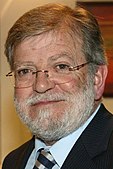2003 Extremaduran regional election
| |||||||||||||||||||||||||||||||||||||||||||||
All 65 seats in the Assembly of Extremadura 33 seats needed for a majority | |||||||||||||||||||||||||||||||||||||||||||||
|---|---|---|---|---|---|---|---|---|---|---|---|---|---|---|---|---|---|---|---|---|---|---|---|---|---|---|---|---|---|---|---|---|---|---|---|---|---|---|---|---|---|---|---|---|---|
| Opinion polls | |||||||||||||||||||||||||||||||||||||||||||||
| Registered | 881,228 | ||||||||||||||||||||||||||||||||||||||||||||
| Turnout | 666,468 (75.6%) | ||||||||||||||||||||||||||||||||||||||||||||
| |||||||||||||||||||||||||||||||||||||||||||||
 Constituency results map for the Assembly of Extremadura | |||||||||||||||||||||||||||||||||||||||||||||
| |||||||||||||||||||||||||||||||||||||||||||||
The 2003 Extremaduran regional election was held on Sunday, 25 May 2003, to elect the 6th Assembly of the autonomous community of Extremadura. All 65 seats in the Assembly were up for election. The election was held simultaneously with regional elections in twelve other autonomous communities and local elections all throughout Spain.
The
Juan Carlos Rodríguez Ibarra was elected for his sixth and last term in office as President of the Regional Government of Extremadura, as he would announce in September 2006 he would not stand for re-election in 2007.[1]
Overview
Electoral system
The
Voting for the Assembly was on the basis of universal suffrage, which comprised all nationals over 18 years of age, registered in Extremadura and in full enjoyment of their political rights. The 65 members of the Assembly of Extremadura were elected using the D'Hondt method and a closed list proportional representation, with an electoral threshold of five percent of valid votes—which included blank ballots—being applied in each constituency. Alternatively, parties failing to reach the threshold in one of the constituencies were also entitled to enter the seat distribution as long as they ran candidates in both districts and reached five percent regionally. Seats were allocated to constituencies, corresponding to the provinces of Badajoz and Cáceres, with each being allocated an initial minimum of 20 seats and the remaining 25 being distributed in proportion to their populations.[2][3]
The electoral law provided that parties, federations, coalitions and
Election date
The term of the Assembly of Extremadura expired four years after the date of its previous election. Elections to the Assembly were fixed for the fourth Sunday of May every four years. The previous election was held on 13 June 1999, setting the election date for the Assembly on Sunday, 25 May 2003.[2][3][4]
The president had the prerogative to dissolve the Assembly of Extremadura and call a snap election, provided that no motion of no confidence was in process, no nationwide election was due and some time requirements were met: namely, that dissolution did not occur either during the first legislative session or within the legislature's last year ahead of its scheduled expiry, nor before one year had elapsed since a previous dissolution under this procedure. In the event of an investiture process failing to elect a regional president within a two-month period from the first ballot, the Assembly was to be automatically dissolved and a fresh election called. Any snap election held as a result of these circumstances would not alter the period to the next ordinary election, with elected deputies merely serving out what remained of their four-year terms.[2][5][6]
Opinion polls
The table below lists voting intention estimates in reverse chronological order, showing the most recent first and using the dates when the survey fieldwork was done, as opposed to the date of publication. Where the fieldwork dates are unknown, the date of publication is given instead. The highest percentage figure in each polling survey is displayed with its background shaded in the leading party's colour. If a tie ensues, this is applied to the figures with the highest percentages. The "Lead" column on the right shows the percentage-point difference between the parties with the highest percentages in a poll. When available, seat projections determined by the polling organisations are displayed below (or in place of) the percentages in a smaller font; 33 seats were required for an
- Color key:
Exit poll
| Polling firm/Commissioner | Fieldwork date | Sample size | Turnout | CE | Lead | ||||
|---|---|---|---|---|---|---|---|---|---|
| 2003 regional election | 25 May 2003 | — | 75.6 | 51.7 36 |
38.7 26 |
6.3 3 |
1.8 0 |
[c] | 13.0 |
| Sigma Dos/Antena 3[p 1] | 25 May 2003 | ? | ? | ? 34/35 |
? 27 |
? 3/4 |
– | [c] | ? |
| Ipsos–Eco/RTVE[p 2] | 25 May 2003 | ? | ? | ? 34/36 |
? 25/27 |
? 3/5 |
– | [c] | ? |
| CIS[p 3][p 4] | 22 Mar–28 Apr 2003 | 1,238 | 74.9 | 51.5 35 |
39.2 26 |
7.3 4 |
– | 0.1 0 |
12.3 |
| Vox Pública/El Periódico[p 5][p 6] | 23 Apr 2003 | 805 | ? | 50.0– 51.0 36/37 |
37.5– 38.5 26/27 |
5.0– 6.0 2/3 |
1.0– 2.0 0 |
– | 12.5 |
| CIS[p 7][p 8][p 9] | 9 Sep–9 Oct 2002 | 486 | 79.3 | 50.3 | 39.6 | 6.7 | – | – | 10.7 |
| 2000 general election | 12 Mar 2000 | — | 75.4 | 44.7 31 |
47.3 32 |
4.7 2 |
0.7 0 |
0.4 0 |
2.6 |
| 1999 regional election | 13 Jun 1999 | — | 73.4 | 48.5 34 |
40.0 28 |
6.1 5 |
1.7 0 |
1.2 0 |
8.5 |
Results
Overall
 | ||||||
| Parties and alliances | Popular vote | Seats | ||||
|---|---|---|---|---|---|---|
| Votes | % | ±pp | Total | +/− | ||
| Spanish Socialist Workers' Party–Progressives (PSOE–p)1 | 341,522 | 51.66 | +2.03 | 36 | +2 | |
| People's Party (PP) | 255,808 | 38.70 | –1.31 | 26 | –2 | |
| United Left–Independent Socialists of Extremadura (IU–SIEx)2 | 41,448 | 6.27 | –0.74 | 3 | ±0 | |
| United Extremadura (EU) | 12,171 | 1.84 | +0.17 | 0 | ±0 | |
| Humanist Party (PH) | 1,082 | 0.16 | New | 0 | ±0 | |
| Blank ballots | 9,033 | 1.37 | +0.22 | |||
| Total | 661,064 | 65 | ±0 | |||
| Valid votes | 661,064 | 99.19 | –0.19 | |||
| Invalid votes | 5,404 | 0.81 | +0.19 | |||
| Votes cast / turnout | 666,468 | 75.63 | +2.19 | |||
| Abstentions | 214,760 | 24.37 | –2.19 | |||
| Registered voters | 881,228 | |||||
| Sources[7][8] | ||||||
Footnotes:
| ||||||
Distribution by constituency
| Constituency | PSOE–p | PP | IU–SIEx | |||
|---|---|---|---|---|---|---|
| % | S | % | S | % | S | |
| Badajoz | 53.5 | 20 | 37.2 | 13 | 6.9 | 2 |
| Cáceres | 48.8 | 16 | 41.0 | 13 | 5.3 | 1 |
| Total | 51.7 | 36 | 38.7 | 26 | 6.3 | 3 |
| Sources[7][8] | ||||||
Aftermath
| Investiture Juan Carlos Rodríguez Ibarra (PSOE) | ||
| Ballot → | 23 June 2003 | |
|---|---|---|
| Required majority → | 33 out of 65 | |
36 / 65
| ||
29 / 65
| ||
| Abstentions | 0 / 65
| |
| Absentees | 0 / 65
| |
| Sources[8] | ||
Notes
References
- Opinion poll sources
- ^ "El sondeo de Sigma Dos determina una lucha codo a codo entre populares y socialistas en Madrid". ABC Sevilla (in Spanish). 25 May 2003. Archived from the original on 25 May 2019. Retrieved 19 May 2019.
- ^ "Sondeo a pie de urna de Ipsos Eco Consulting para TVE". ABC Sevilla (in Spanish). 25 May 2003. Archived from the original on 7 December 2017. Retrieved 11 December 2017.
- ^ "Preelectoral elecciones autonómicas, 2003. CA de Extremadura (Estudio nº 2492. Marzo-Abril 2003)" (PDF). CIS (in Spanish). 17 May 2003.
- ^ "La guerra pasa factura electoral al PP". La Vanguardia (in Spanish). 18 May 2003.
- ^ "Ibarra volvería a barrer en Extremadura". El Periódico de Aragón (in Spanish). 4 May 2003.
- ^ "VOX PUBLICA". El Periódico de Aragón (in Spanish). 4 May 2003.
- ^ "Instituciones y autonomías, II. CA de Extremadura (Estudio nº 2455. Septiembre-Octubre 2002)". CIS (in Spanish). 19 November 2002.
- ^ "El PP, partido más votado en diez Comunidades Autónomas" (PDF). El Mundo (in Spanish). 19 November 2002.
- ^ "El PP ganaría las autonómicas en diez Comunidades y el PSOE en cuatro, según el CIS". ABC (in Spanish). 20 November 2002.
- Other
- ^ "Rodríguez Ibarra will not stand for re-election" (in Spanish). El País. 2006-09-19.
- ^ a b c d Ley Orgánica 1/1983, de 25 de febrero, de Estatuto de Autonomía de Extremadura (Organic Law 1) (in Spanish). 25 February 1983. Retrieved 17 March 2017.
- ^ a b c Ley 2/1987, de 16 de marzo, de Elecciones a la Asamblea de Extremadura (Law 2) (in Spanish). 16 March 1987. Retrieved 17 March 2017.
- ^ a b Ley Orgánica 5/1985, de 19 de junio, del Régimen Electoral General (Organic Law 5) (in Spanish). 19 June 1985. Retrieved 28 December 2016.
- ^ Ley Orgánica 5/1991, de 13 de marzo, de Reforma del Estatuto de Autonomía de Extremadura (Organic Law 5) (in Spanish). 13 March 1991. Retrieved 8 April 2017.
- ^ Ley Orgánica 12/1999, de 6 de mayo, de reforma de la Ley Orgánica 1/1983, de 25 de febrero, de Estatuto de Autonomía de Extremadura (Organic Law 12) (in Spanish). 6 May 1999. Retrieved 8 April 2017.
- ^ a b "Assembly of Extremadura election results, 25 May 2003. Badajoz and Cáceres" (PDF). www.juntaelectoralcentral.es (in Spanish). Electoral Commission of Extremadura. 5 June 2003. Retrieved 26 September 2017.
- ^ a b c "Eleccions a la Asamblea de Extremadura (1983 - 2019)". Historia Electoral.com (in Spanish). Retrieved 26 September 2017.



